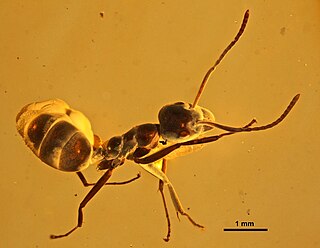
Dolichoderus is a genus of ants found worldwide.

Aphaenogaster sommerfeldti is an extinct species of ant in the subfamily Myrmicinae known from a group of Middle Eocene fossils found in Europe. A. sommerfeldti is one of three species in the ant genus Aphaenogaster to have been noted from fossils found in Baltic amber by William Morton Wheeler.

Aphaenogaster oligocenica is an extinct species of ant in the subfamily Myrmicinae known from a pair of Middle Eocene fossils found in Europe. A. oligocenica is one of three species in the ant genus Aphaenogaster to have been noted from fossils found in Baltic amber by William Morton Wheeler.

Aphaenogaster mersa is an extinct species of ant in the subfamily Myrmicinae known from a pair of Middle Eocene fossils found in Europe. A. mersa is one of three species in the ant genus Aphaenogaster to have been noted from fossils found in Baltic amber by William Morton Wheeler.

Asymphylomyrmex is an extinct genus of ants in the formicid subfamily Formicinae. The genus contains a single described species, Asymphylomyrmex balticus and is known from a group of Middle Eocene fossils which were found in Europe.
Eldermyrmex is an extinct genus of ant in the Formicidae subfamily Dolichoderinae. The genus contains a single described species Eldermyrmex oblongiceps. Eldermyrmex is known to be from the Baltic Amber.

Yantaromyrmex is an extinct genus of ants first described in 2013. Members of this genus are in the subfamily Dolichoderinae of the family Formicidae, known from Middle Eocene to Early Oligocene fossils found in Europe. The genus currently contains five described species, Y. constrictus, Y. geinitzi, Y. intermedius, Y. mayrianum and Y. samlandicus. The first specimens were collected in 1868 and studied by Austrian entomologist Gustav Mayr, who originally placed the fossils in other ant genera until the fossils were reviewed and subsequently placed into their own genus. These ants are small, measuring from 4 to 6 mm in length and can be characterized by their trapezoidal shaped head-capsules and oval compound eyes that are located slightly to the rear of the capsules midpoint, with no known ocelli present.
Dolichoderus brevicornis is a species of ant in the genus Dolichoderus. Described by Dlussky in 2002, remains of the species were discovered in the Baltic Amber.
Dolichoderus brevipalpis is an extinct species of ant in the genus Dolichoderus. Described by Dlussky in 2008, the ant is from the Eocene epoch, being discovered in the Baltic Amber.

Dolichoderus cornutus is an extinct species of Eocene ant in the genus Dolichoderus. Described by Mayr in 1868, the fossils were discovered in the Baltic amber, where a fossilised worker ant was only described, and it is presumed these ants existed at least 40 million years ago.
Dolichoderus elegans is an extinct species of Eocene ant in the genus Dolichoderus. Described by William Morton Wheeler in 1915, the fossilised remains of the species were found in the Baltic amber.

Dolichoderus longipilosus is an extinct species of Eocene ant in the genus Dolichoderus. It was described by Dlussky in 2002, and the fossils of the species are only known from a fossilised worker that was found in the Baltic amber.

Dolichoderus nanus is an extinct species of Eocene ant in the genus Dolichoderus. Described by Dlussky in 2002, a fossilised worker was discovered in the Baltic amber.

Dolichoderus passalomma is an extinct species of Eocene ant in the genus Dolichoderus. Described by William Morton Wheeler in 1915, a fossilised worker of the extinct species was discovered in Baltic amber.
Dolichoderus polessus is an extinct species of Eocene ant in the genus Dolichoderus. Described by Dlussky in 2002, a fossilised worker was discovered in the Rivne amber.
Dolichoderus polonicus is an extinct species of Eocene ant in the genus Dolichoderus. Described by Dlussky in 2002, a fossilised worker was discovered in the Baltic amber.
Dolichoderus robustus is an extinct species of Eocene ant in the genus Dolichoderus. Described by Dlussky in 2002, a fossilised worker was discovered in the Rivne amber.
Dolichoderus vexillarius is an extinct species of Eocene ant in the genus Dolichoderus. Described by William Morton Wheeler in 1915, a fossilised worker was found and described from the Baltic amber.

Electromyrmex is an extinct genus of ants in the formicid subfamily Dolichoderinae. The genus contains a single described species, Electromyrmex klebsi and is known from a group of Middle Eocene fossils which were found in Europe.

Nylanderia pygmaea is an extinct species of formicid in the ant subfamily Formicinae known from fossils found in the Prussian Formation of the Baltic region.












